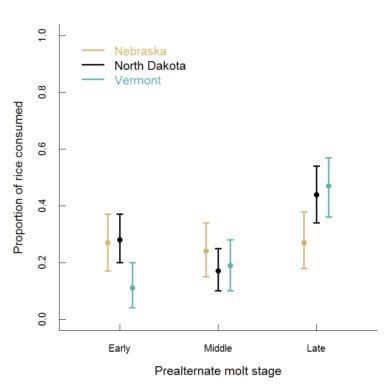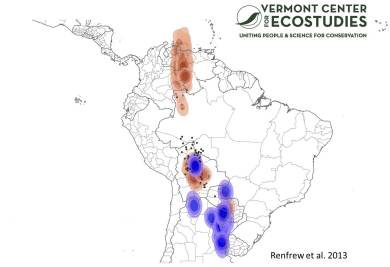For a decade VCE has shed illuminating light on Bobolink migration and wintering ecology. Our research has revealed where Bobolinks go after they leave their breeding grounds, the habitats they use, the food they eat, and the threats they encounter. Guided by these findings, VCE is informing effective full life-cycle conservation, addressing the most pressing threats, and forging new partnerships.
Winter Diet of Bobolinks – clues from feathers
Effectively conserving migratory species requires an understanding of all parts of their life cycle. Until recently, Bobolink conservation focused on addressing threats faced during the breeding season, without much knowledge about what happened to them the rest of the year. A basic understanding of their ecology outside of the breeding season, such as where they live, what they eat, and what threats they face, was lacking. We did know, however, that they ate rice on the wintering grounds, to the point where they were considered a pest by rice farmers. But how much do they really rely on rice, and does that differ depending on where a Bobolink breeds?

The proportion of rice in the diet of Bobolinks on the wintering grounds, for different breeding populations. More rice was consumed late in the molt, and birds that breed in Nebraska consumed less rice in winter than birds from other breeding populations.
Learning more about what happens at that other mysterious end requires traveling to where the Bobolinks go. But given Bobolinks fly some 6,000 miles between its breeding and wintering grounds, studying their wintering ecology from here in North America has its challenges…usually. In the case of the Bobolink, there is one way around this challenge if you want clues about its winter diet. The magic behind the method is elegantly and intuitively explained in “A Bobolink’s Carbon Footprint” by Bryan Pfeiffer, published in Northern Woodlands Magazine.
We found that while rice is an important component of the Bobolinks winter diet, they still rely even more heavily on other plants, presumably natural grasses. But rice is important during a critical time when Bobolinks are completing their winter molt and also preparing for their rapid northward migration. The resulting paper (link below) is published in The Condor, and the journal summarizes the implications of the findings in “Birds’ Feathers Reveal Their Winter Diet.”
-
Renfrew, R. B., J. M. Hill, D. H. Kim, C. Romanek, and N. G. Perlut. 2017. Winter diet of Bobolink, a long-distance migratory grassland bird, inferred from feather isotopes. Condor 119:439-448. doi: 10.1650/CONDOR-16-162.1
Bobolink Migration Patterns and Wintering Sites

Bobolinks breeding in Oregon, Nebraska, and Vermont all converge into 3-6 week stops (brown) and 3-4 month wintering areas (blue) in South America.
Bobolinks can be found in North America from Oregon to Maine, and from British Colombia to Nova Scotia. Do populations that breed in such disparate regions also migrate and winter in different places? Using light-level geolocators, VCE and collaborators found that Bobolinks from across the breeding range— Oregon, Nebraska, and Vermont—all converge in time and space in South America. Nearly the entire population funnels through the Llanos grasslands of Venezuela and then the lowlands of eastern Bolivia.
This geolocator research provides critical knowledge for full life cycle conservation. We now know where to focus conservation action, who to partner with, and can assess threats to Bobolinks during the non-breeding season. The geolocators revealed much more about Bobolink migration (see link below), and this work continues across the Bobolink range in Canada.
Renfrew, R. B., D. Kim, N. Perlut, J. Fox, J. Smith, and P. P. Marra. 2013. Phenological matching across hemispheres in a long-distance migratory bird. Diversity and Distributions 19:1008–1019. (Abstract)
Pesticides
A nerve-disrupting, highly toxic organophosphate called monocrotophos is widely used on crops in many South American countries. VCE documented exposure of Bobolinks to this insecticide at lethal and sublethal levels in Bolivian rice fields. Using our findings, we facilitated discussions between toxicologists and Bolivia’s industry, governmental, and NGO leaders to explore ways to rid the country of the problem pesticide. The Bolivian government, also concerned with the ill effects of monocrotophos on farmworkers, responded swiftly and banned it for use on these crops. We continue to explore the use and effects of pesticides in other countries where Bobolinks feed in agricultural fields.
- Parsons, K. C., P. Mineau, and R. B. Renfrew. 2010. Effects of pesticide use in rice fields on birds. Waterbirds 33 (SP1):193-218. (Abstract)
Blood Parasites
Each year a few dozen Bobolinks pass through the Galapagos in the fall, apart from where the bulk of the Bobolink population migrates. We provided blood samples to our collaborators at Louisiana State University who determined that Bobolinks serve as a source of two types of avian malaria that infect Galapagos birds.
- Levin, I. I., R. E. Colborn, D. Kim, N. G. Perlut, R. B. Renfrew and P. G. Parker. 2016. Local parasite lineage sharing in temperate grassland birds provides clues about potential origins of Galapagos avian Plasmodium. Ecology and Evolution. DOI: 10.1002/ece3.1894
- Levin, I.I., P. Zwiers, S. L. Deem, E. A. Geest, J. M. Higashiguchi, T. A. Iezhova, G. Jim´enez-ucz´ategui, D. H. Kim, J. P. Morton, N. G. Perlut, R. B. Renfrew, E. H. R. Sari, G. Valkiunas, and P. G. Parker. 2013. Multiple lineages of avian malaria parasites (Plasmodium) in the Galapagos Islands and evidence for arrival via migratory birds. Conservation Biology. DOI: 10.1111/cobi.12127. (Abstract)
OTHER RELATED Peer-reviewed journal papers
- Perlut, N. P. and R. Renfrew. 2017. Stopover on Galapagos During Autumn Migration of Bobolinks (Dolichonyx oryzivorus). Wilson Journal of Ornithology 128:935-938. DOI: 10.1676/15-195.1
- Renfrew, R., A.M. Strong, N.G. Perlut, S.G. Martin and T.A. Gavin. 2015. Bobolink (Dolichonyx oryzivorus), The Birds of North America Online (A. Poole, Ed.). Ithaca: Cornell Lab of Ornithology; Birds of North America Online: http://bna.birds.cornell.edu/bna/species/176
DOI: 10.2173/bna.176 - Renfrew, R., S. J. K. Frey, and J. Klavins. 2011. Phenology and sequence of the complete prealternate molt of Bobolinks in South America. Journal of Field Ornithology 82:101-113. (Abstract)
- Renfrew, R.B. and A.M. Saavedra 2007. Ecology and conservation of Bobolinks in rice production regions of Bolivia. Ornitologia Neotropical 18:61-73. (Abstract)
- Renfrew, R.B. 2007. An interspecific foraging association between Nearctic-Neotropical Migrant Passerines in Bolivia. Wilson Journal of Ornithology 119:124-126. (Abstract)
